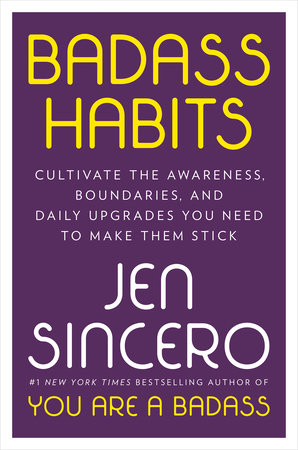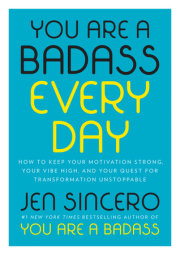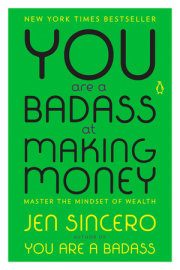Chapter 1
Who You're in the Habit of Being
My brother Stephen and his wife, Jenny, came for a visit one year during Fiesta de Santa Fe, a historical celebration that attracts thousands of people to my New Mexican hometown every fall. We didn't participate in any of the festival's festivities during their stay, but we did brave the throngs of revelers in order to walk downtown and have ourselves some margaritas. The walk took us about forty-five minutes each way, and after a lovely afternoon of cocktailing we found ourselves back in my driveway just as the sun was setting. We stood around, taking in the reddening sky, slightly buzzed on tequila and the smug satisfaction of having made it all the way there and back on foot, when out of nowhere, Jenny started clutching at her throat as if she couldn't breathe. She'd suddenly realized, with horror, that somewhere along the way her diamond pendant had fallen off the chain around her neck and was lost.
My brother immediately flew into action. "I'll retrace our steps," he said, his eyes thoroughly scanning the ground beneath Jenny's feet before he slowly and methodically turned and headed back out my driveway. I began protesting that it would be dark in a matter of minutes, that he was high if he thought he could find her itty-bitty diamond among the sea of fallen leaves and hordes of people, but Jenny turned to me and said, "Let him go. He's weirdly amazing at finding shiny things. He's like a crow." So we stood and watched as Steve headed down my street and back into town, with nothing but his cell phone flashlight lighting his way and the thrill of the quest lighting his heart.
Meanwhile, Jenny and I got in my car and headed back to the bar to crawl around on the floor and see if we could find her pendant ourselves. On the way we passed Stephen, who simply raised his free hand in the air and waved when he heard us honk and holler, unwilling to take his eyes off the ground for even a second. After about ten minutes of trying, and failing, to find a parking place in the midst of the melee, I was about to give up and head back home when we got a text from my brother that read: "Found it!" To which I replied, "I don't believe you," to which he replied with a picture of himself standing in the middle of the street, each arm around a tourist he'd talked into posing with him, proudly holding Jenny's pendant in his front teeth. I later learned it had been kicked off the sidewalk into someone's driveway and that he found it anyway. My jaw hit the floor and has remained there ever since, but Jenny just shook her head and said, "I'm telling you, he's a crow. He finds shit all the time."
Steve used to have a job in the diamond business as a sorter. He'd spend his days in a room called "the pit" with a handful of other sorters, categorizing large piles of not-so-large diamonds according to the three Cs-cut, carat, color-by holding each one up to a light with a pair of tweezers and looking at it through a loupe. While inspecting a diamond, it wasn't uncommon to accidentally tweeze it a bit too hard and send it ricocheting across the room-doink!-where it would land somewhere on the not-so-clean linoleum floor, on a shelf, or perhaps in someone's hair. There was no telling how many precious stones had gone missing in the pit over the years, and finding them became a perpetual Easter egg hunt, one that Steve participated in with vigor every time he put down his tweezers, for the two years that he worked there.
This is how, in the basement of a diamond wholesaler on Forty-Seventh Street in New York City, Steve became the Patron Saint of Lost Shiny Things. His impressive résumé went on to boast of a diamond earring discovered on the floor of a crowded deli; a tennis bracelet spotted next to an ATM machine; countless coins, chains, keys, watches, precious stones; and one morning, while walking to the train, he found the necklace that Jenny (the Patron Saint of Broken Clasps) had lost three months before, nestled in the top of a snowbank.
Steve never zeroed in on the tiny, lost, and shiny until he worked in the diamond business. But thanks to that job, always being on the lookout-consciously and unconsciously-became a habit.
Habits: no-brainers. A routine tendency or behavior. Knee-jerkery. Beliefs, thoughts, and actions that one repeats on autopilot.
Here are some of the key elements involved in habit creation:
The Trigger. Every time Steve took a pause from his work, it triggered his habit of scoping the room for lost diamonds. Triggers send cues to our brains that it's time to perform a habit. A trigger can be a sound (the noise from an alarm clock triggers us to wake up and get out of bed), an action (finishing dinner is a trigger to light a ciggy), a thought (It's four o'clock, so I reckon I should feed the dog), a feeling (when the temperature drops, you rub your arms to warm up), a smell (when you smell your neighbors BBQing, you casually swing by, Oh, I didn't realize you were cooking, is this a bad time?), a sight (seeing a person on the street is a trigger to say hello), or an emotion (feeling upset is a trigger to eat a cherry pie). Triggers begin a chain reaction that results in the completion of the habit. And the sequence goes a little sumthin' like this:
The Sequence. Our bodies are expert problem solvers, running around with a clipboard, making sure everything's working in the most efficient and productive manner possible: moving blood where it's needed most; breaking down food; healing broken bones and torn skin; sprouting hair and toenails; taking down disease; unleashing a flood of tears and obscenities when you accidentally drop your phone in the toilet. Habits are the body's way of lightening the load on our brains, of putting problem-solving on autopilot in order to free up room to take in more information and perform more tasks. Habits work in a sequence of sorts that starts with the trigger (getting in the car), which signals a need (I don't want to die), which then leads to a habit or response (putting on a seat belt), which then leads to the reward (I feel snuggly and safe). Here are some more examples:
Trigger: Your dog walks into the room.
Need: To physically experience his insane cuteness.
Response/habit: Smothering, kissing, acting like a moron.
Reward: You feel happy.
Trigger: You're driving home from work.
Need: To live a longer, healthier life.
Response/habit: Stop at the gym and work out for forty-five minutes.
Reward: You feel invigorated and have a sense of accomplishment.
Trigger: Your divorce lawyer calls.
Need: To not throw a plate at the wall.
Response/habit: Pace around in circles and twirl your hair around your finger.
Reward: You feel calmer.
These are all examples of how triggers set your habits into motion, but triggers can also be used to help you quit bad habits, and I'll show you how to do that later in the book.
Repetition. Think of your brain as a jungle full of images and ideas and feelings all growing and twisting and tangling around one another as you gather more and more information throughout your life. Now imagine that all of your thought patterns and knee-jerk reactions and beliefs about the way things are have cut well-worn paths through this jungle in your mind, paths that you walk down every day, doop de do, without even needing to look where you're going. When you decide to make a change-Hey, I'm no longer gonna be a lazy, out-of-shape person who secretly litters, I'm gonna step it up and get me some different habits-repetition is the tool you'll use to hack through the vines, wrestle fallen trees out of your way, and forge a new path through the jungle of your mind.
Repetition of your new habit will require some mental and physical effort at first, but the scales on the piano that you struggle to remember and execute become second nature after you've played them three hundred times; tying your shoes after decades of doing it takes zero thought these days; answering questions with a You betcha, tiger! unconsciously comes flying out of your mouth after making fun of Grandma for saying it your whole life. I'm so in the habit of calling my mother to check in on her when I get in my car each morning that I once dialed her up while she was sitting right next to me, in town for a visit.
When you repeat something enough times, you establish new neural pathways in the brain that
your habit flows through effortlessly and automatically, allowing you to literally fuggetaboutit.
Take a moment right now to think about something you used to struggle with that's now a habit-working your cell phone, shaving, hitting a tennis ball, driving a car, respecting your neighbor Sarah's wishes that you refer to her as Desert Flower from now on. It's nearly impossible to remember all the little details you used to have to keep in mind when you were anchoring in this-behavior-that's-now-a-habit, because you literally changed the wiring of your brain through repetition.
Ease. It's no big surprise to discover that the easier things are, the more likely we are to do them. This goes for the habits we'd like to form, the habits we'd like to break, and the habits we don't even realize we've signed up for (which, believe you me, account for an alarming amount of them-thanks, Mom and Dad!). My brother didn't set out to be the guy who finds sparkly stuff that most people don't see; he developed the habit because it was easy, it was fun, everyone around him was doing it. He repeated the action of searching over and over again every day, and he got a rush every time he found something good. Steve unwittingly followed the golden rule of habits: The easier you make it to put them on repeat (and the harder you make repeating the habits you want to lose), the more success you'll have.
This is why scheduling new habits first thing in the morning often gets you the best results: It's easier to do things before the distractions of the day worm their way into your progress. This is also why who and what you surround yourself with is so crucial: It's easier to quit drinking soda if you surround yourself with people who don't drink it and if you never keep any in your house; it's easier to go to yoga if the studio's just down the street; it's easier to be successful if you hang out with inspiring, successful people; it's easier to stop watching TV if you keep it in the garage; it's easier to have a negative outlook on marriage if you're raised by divorced, unhappy people; it's easier to accept fish as a breakfast food if you live in Japan.
Patience. Most habits score woefully low in the immediate gratification department. With the exception of things like taking a shower (instant clean and refreshed body!), making your bed (my room's suddenly so tidy!), or eating breakfast (I'm not hungry anymore!), most habits take awhile to produce the desired result, which makes them more difficult to stick with because we humans love us some payoff. Eating lentils instead of ice cream will eventually, hopefully, help lower your cholesterol; lifting weights every day may or may not take forever to produce a tight ab or the swell of a new muscle; meditating for thirty minutes a day may one day make you instantly feel more calm and centered, but first it may leave you wondering what the hell the point is for years. This is why things like relishing the fact that you're showing up at all is so important, why keeping track of the progress you've made so you can see how far you've come is so helpful, why looking for the little victories and rewards is so encouraging (I want to die after the fiftieth sit-up, but I used to want to die after the thirtieth-woot!).
Anchoring in a habit is like moving a giant pile of pebbles from one place to another, stone by stone: You make a tiny dent, hone your moves, it gets easier and easier every time you do it, and eventually you will indeed be staring at a new pile of rocks. You just can't always see your progress as it's happening.
Later in the book I'm going to give you tips that'll help you practice patience and stay the course while your habit takes its own sweet time to settle in, but right now I want to go deeply into the most important tip for creating a new habit-and for making any major upgrade in your life, really:
Shift your identity to match the habits you're adopting.
Identity. Studies have shown that nearly half of the actions we perform every day are habitual: drinking a cup of morning coffee, praying, slouching, bitching, talking with our mouths full, looking for shiny things on the ground, etc. But habits are responsible for much more than just the actions we take. Our beliefs, thoughts, and words are also habits, habits that inform the way we perceive the world around us, mold our identities, and, yes, take the actions we take.
One of the main reasons we fail to stick to new good habits and ditch negative ones is that we focus on changing what we're doing (or not doing) without also making sure that we embrace this habit as a new and valuable part of our identity. For example, if you decide you're going to lose thirty pounds, along with refraining from eating a bunch of crap, filling your fridge with healthy, low-cal food, working out, and getting a tattoo that says If it's fried, it's denied, you also need to become the person who weighs thirty pounds less, who struts around like, Yeah, this is my body, these are my excellent eating habits; it's no biggie, it's just who I am and how I roll. If you're identifying instead as the heavier version of yourself who somehow miraculously dropped thirty pounds, you'll most likely put the weight back on because you're still identifying as someone who has a weight issue. It's why people who win the lottery almost always wind up broke again-they still identify as broke (Me? Rolling in the dough? Who would have ever thunk it? I keep waiting to wake up and wind up back in my normal life, this amount of money doesn't even seem real, etc.) even though they've suddenly become rich.
Copyright © 2020 by Jen Sincero. All rights reserved. No part of this excerpt may be reproduced or reprinted without permission in writing from the publisher.











